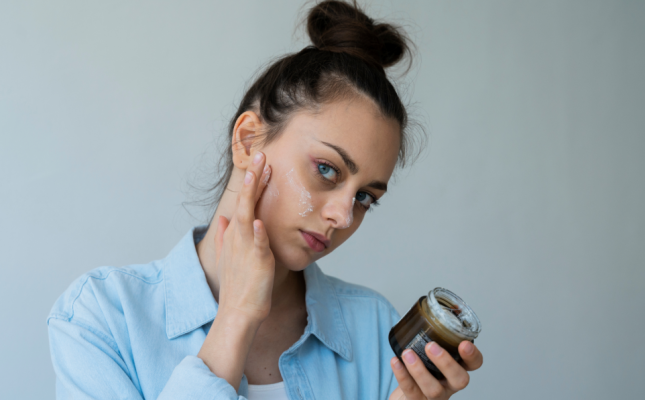Categories – Women’s Wellness
In today’s beauty industry, countless products promise flawless skin, luscious hair, and a youthful glow. However, many of these products contain harmful chemicals that may disrupt your hormones, leading to a host of health problems. From infertility to metabolic issues, these toxins pose significant risks. In this blog, we’ll explore some of the most common hormone-disrupting chemicals lurking in your cosmetics and skincare products and how you can protect yourself.
What Are Hormone Disruptors?
Hormone or endocrine disruptors are chemicals that interfere with the body’s endocrine system. They mimic, block, or alter hormone production, leading to potential reproductive, metabolic, and neurological issues. These chemicals can be found in everything from lotions and shampoos to makeup and perfumes.
that interfere with the body’s endocrine system. They mimic, block, or alter hormone production, leading to potential reproductive, metabolic, and neurological issues. These chemicals can be found in everything from lotions and shampoos to makeup and perfumes.
Common Toxins in Beauty Products
1. Parabens
Parabens are preservatives used in many personal care products to prevent bacterial growth. However, they have been linked to hormone disruption, as they can mimic estrogen in the body. Studies suggest that parabens may contribute to breast cancer

and reproductive issues.
- Where they’re found: Moisturizers, shampoos, conditioners, makeup, and deodorants.
- Safer alternative: Look for paraben-free products labeled with natural preservatives like vitamin E or rosemary extract.
2. Phthalates
Phthalates are chemicals that help fragrances last longer and improve product flexibility. They are known to interfere with testosterone production and have been linked to reproductive disorders in both men and women.
- Where they’re found: Perfumes, nail polishes, hair sprays, and plastic packaging.
- Safer alternative: Choose fragrance-free or naturally scented products with essential oils.
3. Triclosan
Triclosan is an antibacterial agent found in many beauty and personal care products. It disrupts thyroid hormone function and has been linked to antibiotic resistance.
- Where it’s found: Soaps, toothpaste, deodorants, and antibacterial gels.
- Safer alternative: Use products labeled as “triclosan-free” and opt for natural antibacterial ingredients like tea tree oil.
4. Oxybenzone
Oxybenzone is a common ingredient in sunscreens and is known to mimic estrogen, leading to hormonal imbalances and potential developmental problems.
- Where it’s found: Sunscreens, lip balms, and moisturizers with SPF.
- Safer alternative: Look for sunscreens with zinc oxide or titanium dioxide as active ingredients.
5. Formaldehyde and Formaldehyde-Releasing Preservatives
Formaldehyde is a known carcinogen that can also disrupt hormone function. Some preservatives release formaldehyde over time, exposing users to its harmful effects.
- Where they’re found: Nail polishes, hair straightening treatments, and some cosmetics.
- Safer alternative: Opt for formaldehyde-free nail polishes and hair treatments labeled as “non-toxic.”
6. Toluene
Toluene is a solvent used in nail polish and hair dyes. It affects hormone levels and has been linked to neurological damage and reproductive harm.
- Where it’s found: Nail polishes, nail polish removers, and hair dyes.
- Safer alternative: Use non-toxic nail polishes labeled “3-free” or “5-free,” meaning they do not contain toluene, formaldehyde, or other harmful chemicals.
7. Sodium Lauryl Sulfate (SLS) and Sodium Laureth Sulfate (SLES)
These foaming agents strip natural oils from the skin and scalp. They can be contaminated with 1,4-dioxane, a possible carcinogen that also affects the endocrine system.
- Where they’re found: Shampoos, body washes, face cleansers, and toothpaste.
- Safer alternative: Choose sulfate-free shampoos and cleansers made with natural surfactants like coconut-derived ingredients.
How to Avoid These Harmful Chemicals

- Read Labels Carefully: Familiarize yourself with the names of hormone disruptors and avoid products that contain them.
- Choose Organic and Natural Products: Opt for brands that use certified organic and plant-based ingredients.
- Look for EWG-Verified Products: The Environmental Working Group (EWG) provides a database of safer beauty products.
- Make DIY Beauty Products: Consider making your own skincare items using natural ingredients like coconut oil, aloe vera, and essential oils.
- Support Clean Beauty Brands: Many brands are committed to transparency and safety. Do some research to find reputable companies that prioritize non-toxic formulations.
Conclusion
Your beauty routine should enhance your health, not compromise it. Many commercial beauty products contain hidden toxins that disrupt hormones and pose serious health risks. By being informed and making conscious choices, you can protect yourself from these harmful chemicals. Always read labels, opt for natural and organic products, and support brands that prioritize clean, safe ingredients. Your body—and hormones—will thank you!
Are you ready to switch to cleaner beauty products? Start by checking the labels on your favorite items and gradually replacing them with healthier alternatives!

